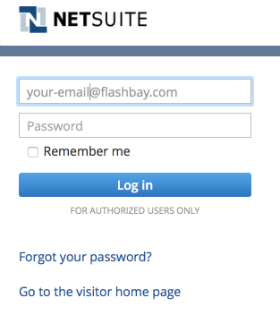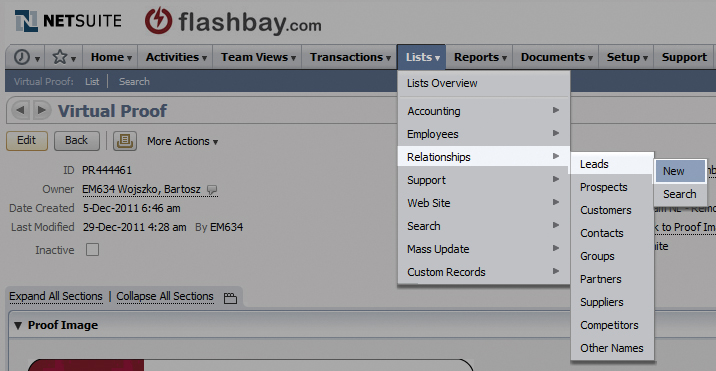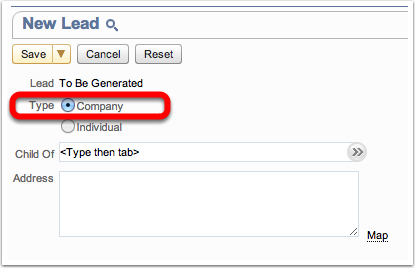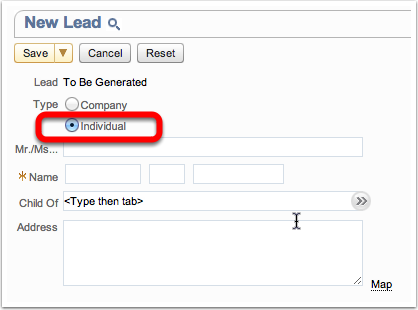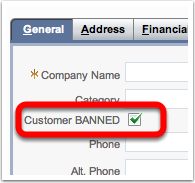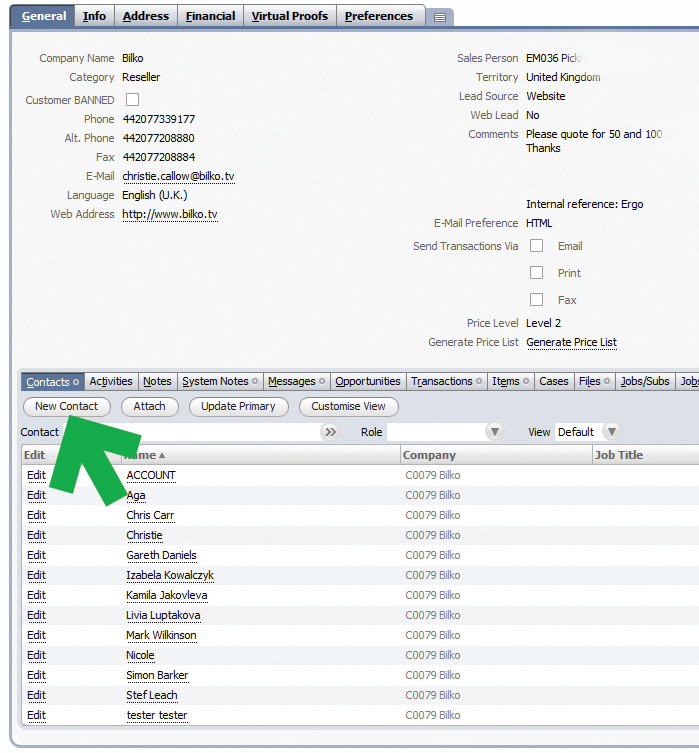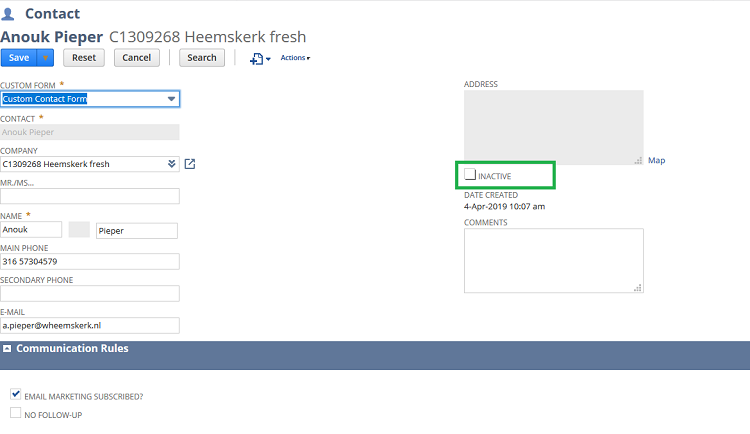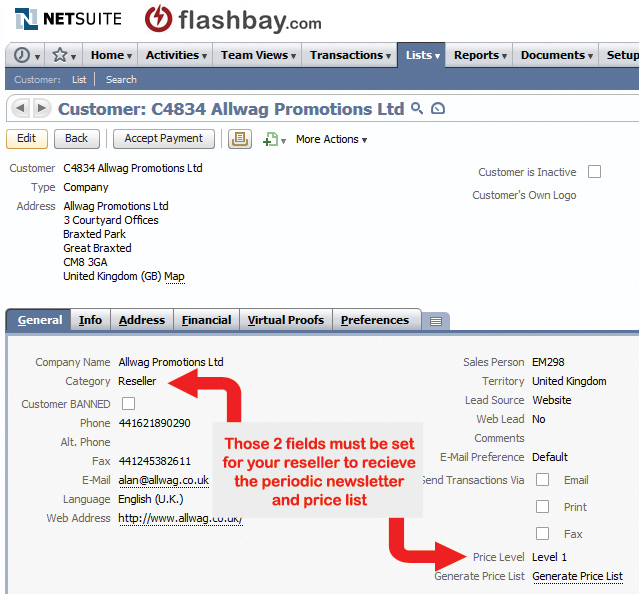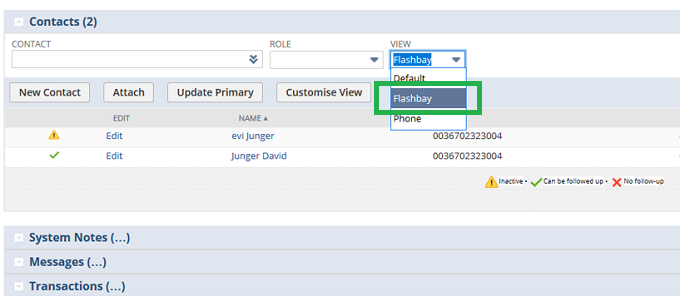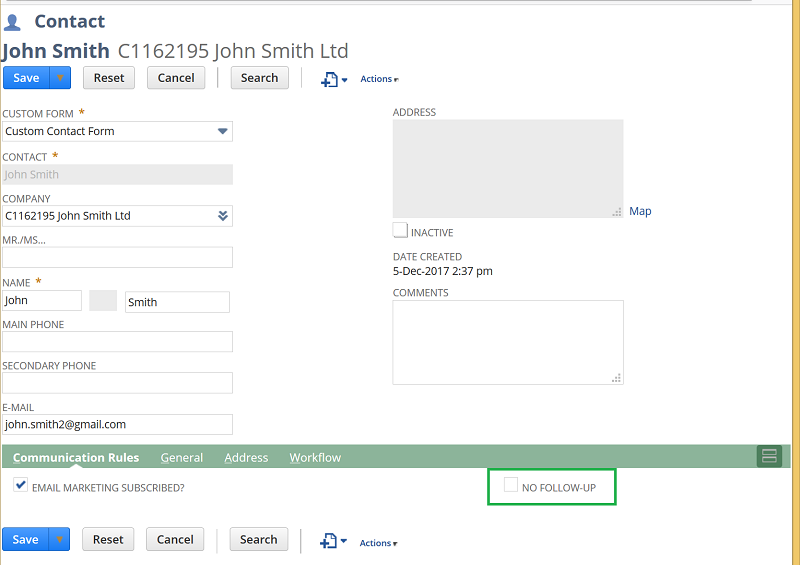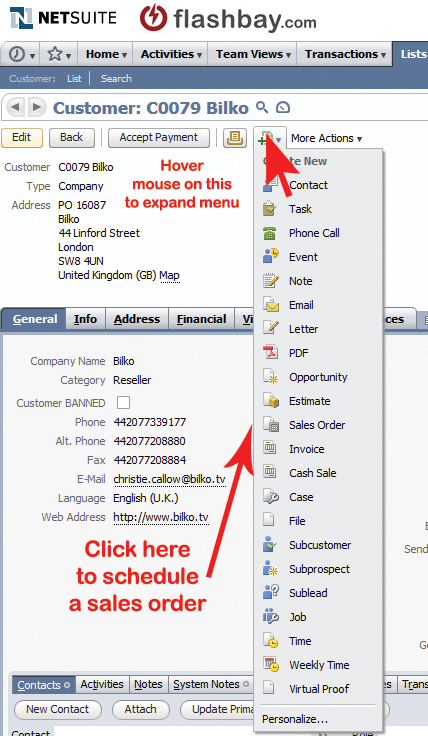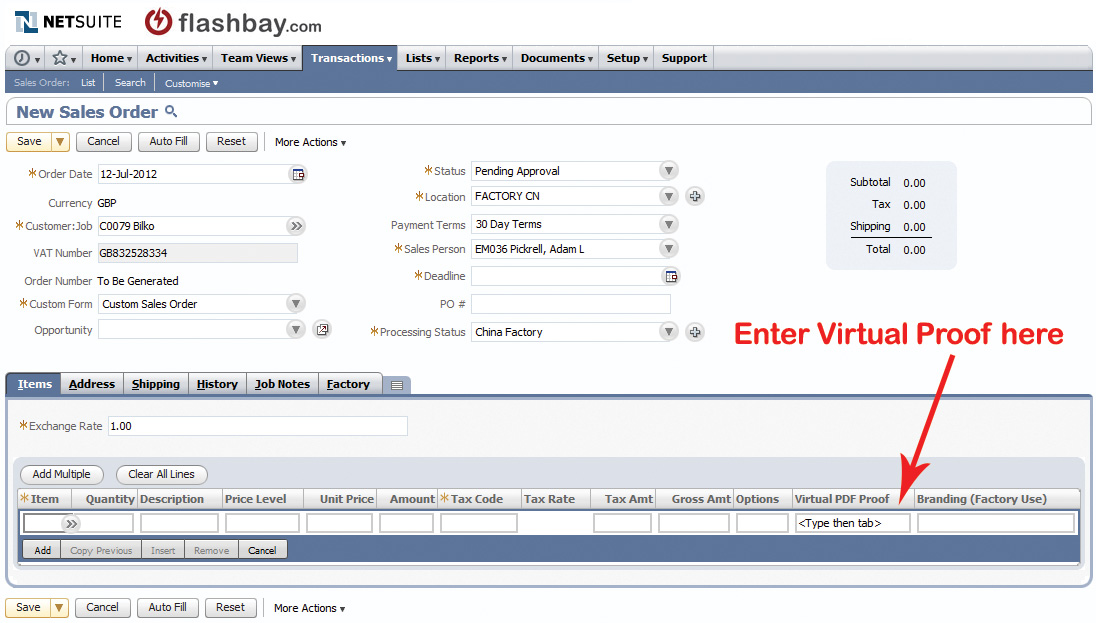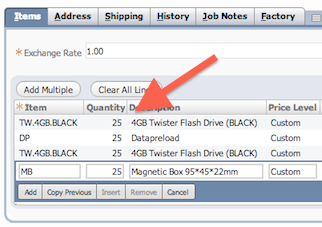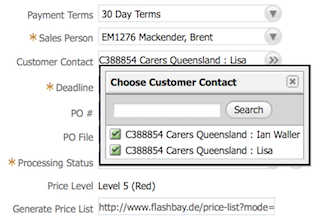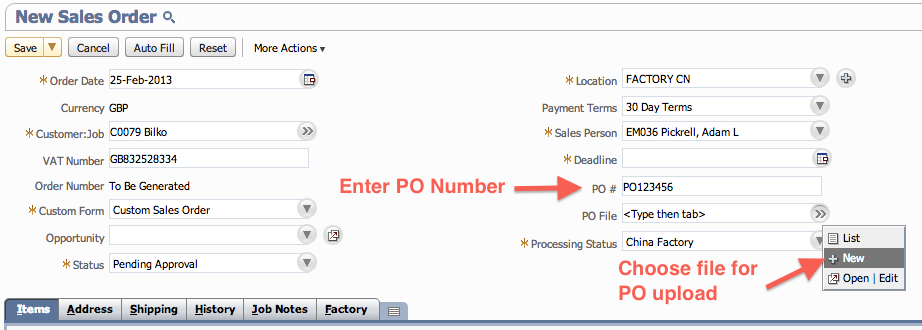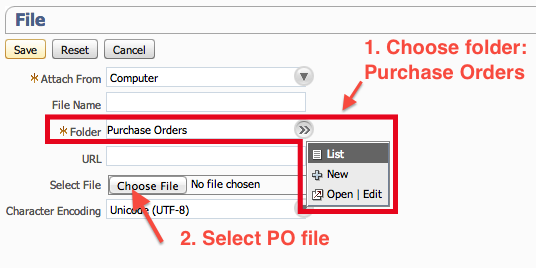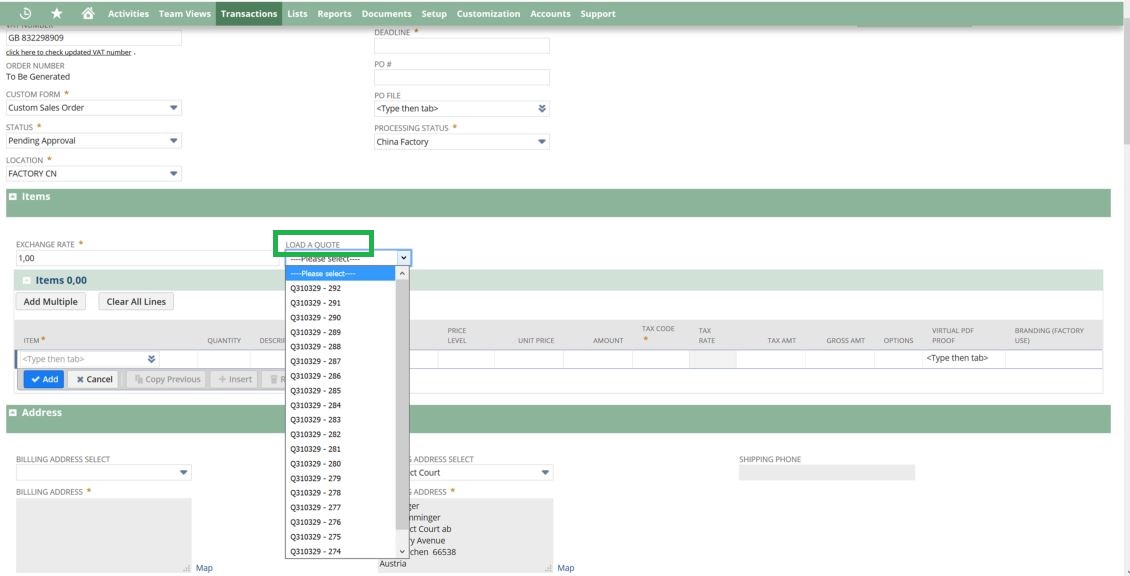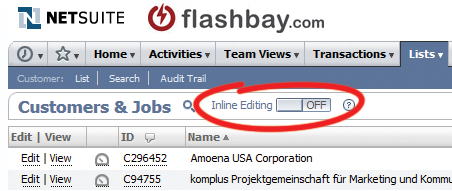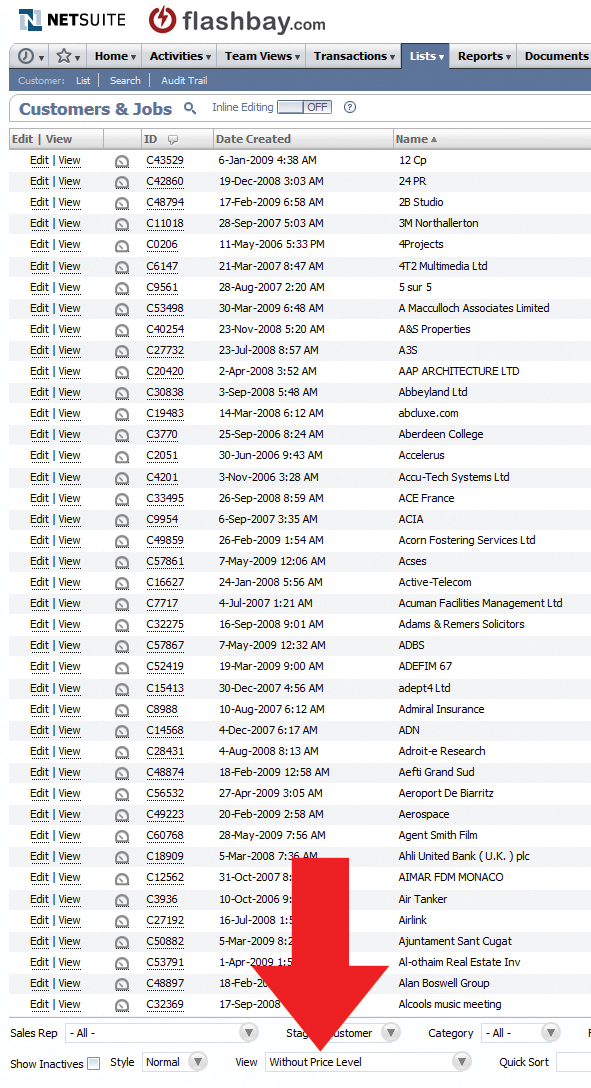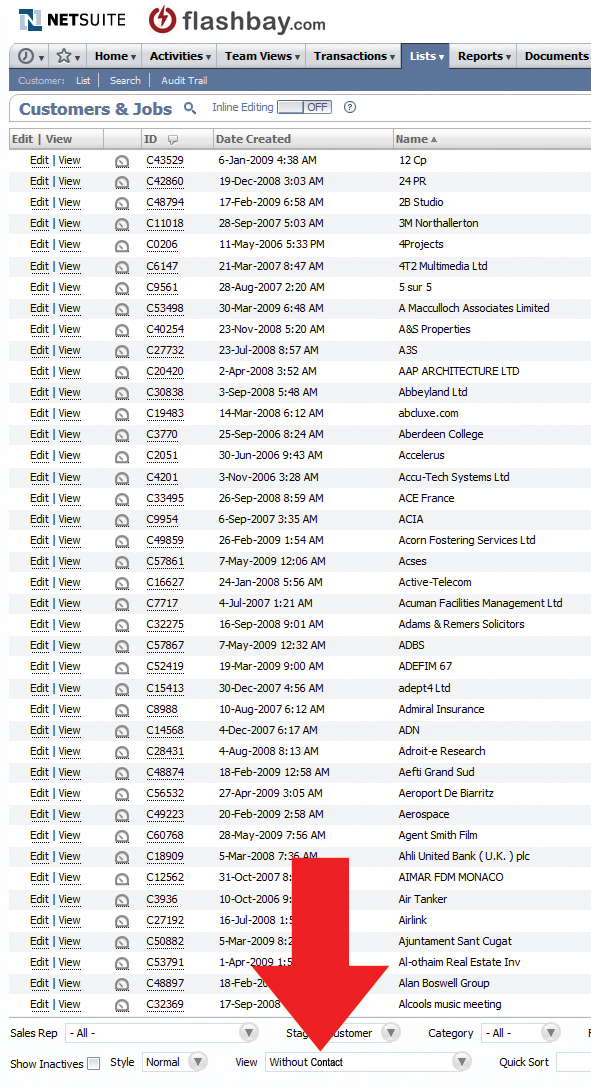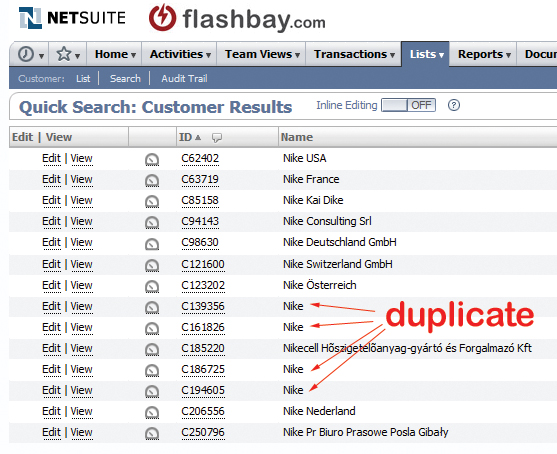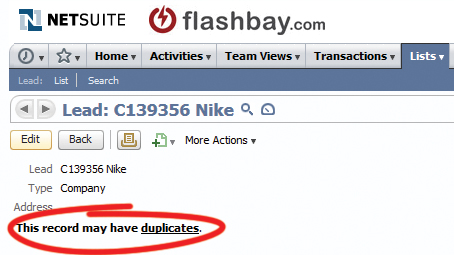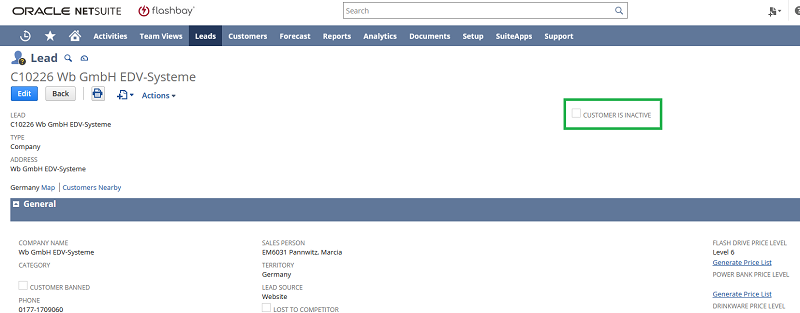Netsuite
Back to Sales Staff Manual Content
<< Previous Article | Next Article >>
Introduction
Netsuite is the CRM/ERP software we use to manage all of our sales processes. It is essential that all sales employees are able to use the various sales features with Netsuite proficiently.
You can access your Netsuite account by going to: https://system.netsuite.com/pages/customerlogin.jsp
CRM Terminology
CRM - acronym for 'Customer Relationship Management'.
Record - an entry into a CRM system containing information. An invoice, sales order, contact and customer are all examples of record types.
Parent record - a record to which 'child' records refer. For example, an invoice record will always belong to a customer record. The invoice is therefore the child and the customer the parent in this case.
Customer - a business/organisation that has transacted with us
Lead - a potential customer. Note a 'Lead' and 'Customer' are the same record in Netsuite, just that a customer record has a sales order belonging to it.
Sales Order- transaction that records a commitment by us to sell items and/or services to a customer
Invoice - itemised statement of money owed to us for goods and/or services rendered
Credit Note - itemised statement of money owed to a customer. Credit notes are applied against open invoices or the amount due is refunded to a customer if no open invoices exist. Credit notes may be issued by the Aftersales team in such cases as late delivery, malfunctioning goods or compensation for any other service shortcomings.
Dashboard - summary screen of customers’ sales orders, invoices and statistics
Contact - a record of a customer containing information on an individual within a company (customer record).
Virtual Proof- a record which visually shows how a logo should be positioned on a product. The record contains a 'proof image' and the artwork used to create it plus additional artwork information such as pantone references and branding technique.
Leads - the basics
At Flashbay, a lead is a company/organisation potentially interested in purchasing our products and services. A lead represents the first stage of the sales cycle.
It is important to note that Flashbay does not sell to private individuals, however, please remember that sole traders are businesses and should not be confused with private individuals.
Additionally, Flashbay does not supply companies/organisations that:
- Sell any USB memory, Audio, Power products on any website under their control (even if they wish to source all their products from Flashbay)
- Have a website or websites dedicated to USB memory, Audio, Power products.
Before progressing with a lead, it is necessary to thoroughly check their website(s) to ensure that they are do not fulfil the above criteria. Pay particular attention where the potential customer is a reseller. Please refer to the section on Competitors for further information.
Where do leads come from?
- Flashbay's internet marketing
- Flashbay's other marketing campaigns (mail outs, email marketing, print advertising)
- Employees reviving interest from old, existing customers.
- Happy customer referrals
How are leads assigned?
- New leads coming via Flashbay's website are assigned between sales team members of the applicable territory
- New leads coming via phone go to the first sales team member available to take the call
- Throughout Flashbay, there are multiple sales teams selling to different countries. Unless special circumstances apply, you should only deal with leads within your designated sales territory
Relationship between Flashbay, the employee and the lead/customer
- Leads and customers remain the property of Flashbay
- Flashbay may provide employee with leads, with the aim of the employee converting these leads into 'customers' by way of an order
- Once an employee has converted a lead to a customer, that customer will remain under that employee management, as long as this is in the best interest of the customer and Flashbay
Lead Aging and the '9 Month Guideline'
Once a lead is assigned to an employee, Flashbay will generally allow the employee 9 months to convert that lead into a customer. If after this time the lead has not been converted into a customer, Flashbay may re-assign that lead to another Flashbay employee to help prevent dead assets accumulating and employees lead portfolio and to allow another employee to work on converting the lead.
Duplicates
Later in the manual, you will learn more about 'duplicates' and how to prevent them by searching in our CRM software. Please note however that before you start dealing with a 'new lead', it's essential to check whether another employee already deals with that company.
Netsuite - Leads
New Lead Notification
A new lead is generated each time a first-time enquirer submits an enquiry via Flashbay's website enquiry form. Netsuite distributes new leads amongst all employees of each country sales teams. Employees will receive an automatic email notification when a lead has been assigned to them.
When an existing lead/customer submits an enquiry, Netsuite will automatically recognise this if they use the same company name, and email the notification to the currently assigned employee.
Please note: Sometimes a customer may use a different spelling of their company name when submitting an online form - this will lead to a duplicate problem. Thus, when you receive a new lead automatically, you must check whether it is a duplicate of an existing lead/customer using the Netsuite global search function. If it is, inactivate the lead, and pass it to the employee who has already been assigned the lead/customer in Netsuite. This check is important to avoid any confusion for all sales employees and customer.
To see your leads in Netsuite click: Lists > Relationships > Leads
Use the Global Search function to find the record of an existing lead/customer.
To clearly see transnational entries you can influence the Global Search result layout by entering 'cust:{customer_name}' (for example cust:Xerox) in the search box rather than just the customer name. This function enables you to search territory specific entries faster.
You will find full details of the enquiry on the notification email you receive.
There are a two other ways in which you will receive new leads:
- Forwarded email originally sent to contact@flashbay.com
- Phone
Customer language preferences
Should an employee come across a Lead or Customer who prefers to converse in a language other than the one spoken in your respective territory, you need to forward this client to the relevant Sales Manager for the alternative territory.
E.g.:
An employee working for the German/Austrian/Swiss territory receives a Lead that prefers to speak English, this must be forwarded to the UK Sales Team Manager.
An employee working for the UK territory is made aware that a new contact of an existing Customer prefers to speak French, this must be forwarded to FR Sales Team Manager.
Response times to new leads
Employees must respond to a new enquiry within <45 mins of receiving the lead, this must be via phone and followed up via email.
Phone vs Email - which communication tool is best
We believe that both email and phone should be used during the initial stage of a new lead.
- Email should be considered as the primary communication method for topics relating to prices, virtual proofs and important order details as such details are best communicated in writing for future reference
- The phone should be used to show the customer there is a real person behind our pre-sales service. This can be a very powerful, persuasive tool when used in addition (but not solely in place of) emails
- Whenever you speak with a customer by phone, be sure to send an email memo afterwards.
Manually entering a new lead into Netsuite
It is important to check whether a lead/customer already exists in Netsuite before manually creating a new lead. The information you save about the lead should be completed in the format outlined below.
To manually create a new lead click: Lists > Relationships > Leads > New
Entering leads into Netsuite
All leads received should be entered into Netsuite using the following rules:
1. Genuine business or institutional (government, schools, charity etc).
These leads should be entered with the "Type" selector set to "Company".
When Type "Company" is selected the lead form displays the contacts tab as normal and multiple contacts can be added for the company.
2. Individuals
To be entered as an individual a lead must meet all the following criteria:
1. The lead was looking for 1 or just a few (less than MOQ) branded or blank units AND
2. The individual represents no company or organisation AND
3. The lead used a free email address
If all 3 of the above criteria are not met then you must enter as a Company and treat like any other lead. (Typically the number of lead records in Netsuite marked as ‘individual’ would be less than 1% of the records you create).
When Type “Individual” is selected the lead form does not display the contacts tab as individuals by definition will only have a single contact, details of which are entered directly on the lead form.
3. Any lead which upon initial investigation would be considered as coming from a competitor.
These leads should be entered with the "Type" selector set to "Company" or "Individual" as appropriate.
The word "BANNED" should be appended to the name and the "customer BANNED" checkbox should be ticked.
There is no requirement to add contacts for leads of Type "Customer" when they are entered as banned from the outset.
Following these rules ensures that the Sales Pipeline and associated statistics function correctly, giving credit for converted leads and ensuring that those leads that should not be considered in such calculations are accurately excluded.
It is strictly forbidden to create 'dummy' customer records and then add new leads to them as contacts (for example, creating C12345 My Private Leads and then adding new leads as contacts to this record).
Every incoming lead must either be entered as a new lead using the above rules or added to an existing lead / customer record if the incoming lead is from a new contact within the same company.
Furthermore, it is wholly unacceptable to purposely misclassify incoming leads as Individuals or Banned when they should have been classified as of type "Company" according to the above rules.
The following data must be entered into a new lead record as a minimum:
- Company Name: Ensure that spelling is accurate and ensure the appropriate capitalisation is used. The company’s actual name should be entered, rather than their trading name.
- Category: Blank by default (more info below on customer categories)
- Phone: Omit 00 or + before country code and leave no spaces between numbers. e.g. 442073717333 is how our office number should be written
- Alt. Phone & Fax: Enter in the same format as phone number if information is available
- Email Address
- Customer's website Enter when available so you gain quick access to all his information
- Payment Terms: By default, the payment terms of a new customer are set to advance payment. If a lead is converted into a customer, an advanced payment invoice will be emailed to the address saved in the above field.
- Territory: This dictates the language in which documentation will be sent to contacts
Click ‘Save’ once you have completed the above fields.
The next step us to set up the contact record which belongs to this customer record.
Creating a New Contact
All contacts of a lead/customer should be set up in Netsuite, even if their email address is saved on the global record. Click ‘New Contact’ and fill in the fields accordingly. Only email addresses saved under the Contacts section of the General tab in Netsuite are able to gain access to the website’s Customer Centre.
Marking inactive Old Contact
Should an employee be aware that a contact has left the company or is working in a different department and no longer responsible for dealing with Flashbay, you should mark inactive this contact.
This can be done on contact level (click 'Edit' on the contact, tick 'Inactive' and Save).
Netsuite - Customer Categories
For the purposes of Netsuite, we essentially supply 2 types of customers – resellers and final customers. There are a few settings in Netsuite to be aware of when managing resellers. If an employee is unsure of the lead’s nature of business, it is recommended they view their website to find out more information. This will help differentiate the lead between a 'reseller' and a 'final customer'.
The 'Category' in Netsuite is set default to final customer (in this case the 'Category' section stays blank). If you are dealing with a reseller, the ‘Category’ field in their Netsuite record should be set to Reseller. The category for 'final customers' should be left blank or set to Education if applicable. The latter will make it easier for anyone viewing the record to know they are looking at that of an educational establishment.
Netsuite - Contact Preferences
Note: previously you could amend Marketing Preferences on the customer main page, this was disabled.
All such updates are to be performed only at the contact level as Preferences tab on a customer level no longer exist.
1. How to check contact preferences?
Prior to contacting an existing contact, always check NS to see their preference:
Green tick - Can be followed up: you can get in touch/follow up with the lead or customer.
Red cross - No follow up: customer/lead can not be contacted.
Yellow triangle - Inactive: contact does not exist anymore.
2. What if you can not see the contact's preference?
If you can not see the contact's preference, please choose Flashbay view on the customer contacts tab.
3. How to change the contact's preference?
Occasionally it will happen, that your contact expresses a desire not to be contacted by phone or email, or not to be contacted at all.
In such cases you should edit the contact’s preference accordingly.
1. ‘Email Marketing Subscribed’
If your contact specified that he does not want to receive any marketing related email (such as the quarterly marketing emails), proceed as below:
Click ‘Edit’ on the contact you need to amend and untick ‘Email Marketing Subscribed’ then save.
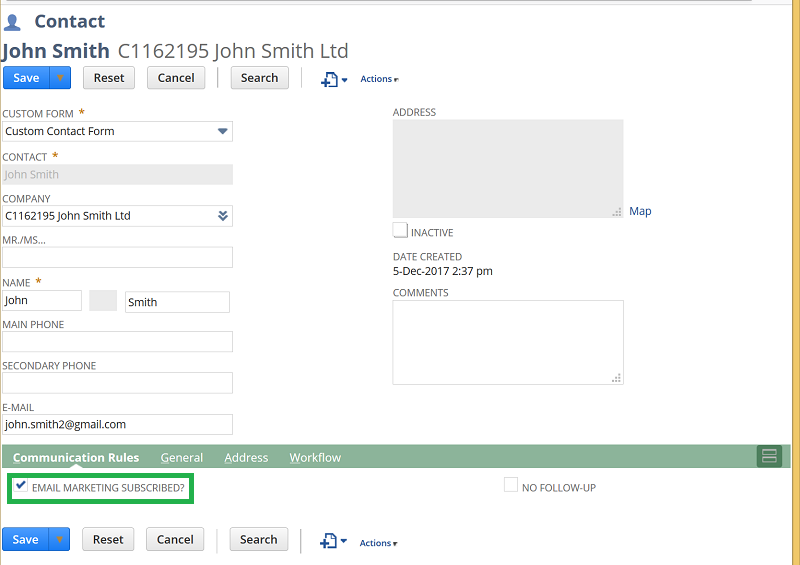
Example: Customer replied to the quarterly marketing email asking to be unsubscribed.
You should untick customer Email Marketing Subscribed, so customer will not receive any automated emails, however you can still get in touch with them via call or email.
2. ‘No follow up’
If your contact specified that he does not want to be approached by any Sales employee directly via email or phone call, or does not want to have any contact from Flashbay, proceed as below:
Click ‘Edit’ on the contact you need to amend and tick ‘NO FOLLOW-UP’ then save.
How to follow up on 180 day customers?
If at least one contact of a customer has ‘NO FOLLOW-UP’ checkbox unticked, the customer will appear in 180 days not contacted list.
When a customer has many contacts, if one of them does not want to be contacted it does not necessarily mean that they all do not want to be contacted.
Example: Customer has 5 contacts out of which for 4 checkbox is ticked ‘NO FOLLOW-UP’ and for one contact ‘NO FOLLOW-UP’ checkbox is unticked. In this case customer will appear in the 180 days not contacted list and you can follow up but only with the one that has the checkbox unticked.
Before following up from the 180 day not contacted list, you should refer to NetSuite contacts list to check whether the particular contact is ok to follow up or not.
Green tick next to a contact implies ok to follow up; a red cross next to a contact implies no follow up should be done by you or any other Sales Account Manager.
Netsuite - Scheduling a Sales Order
Introduction
Ensure that all aspects of an order have been approved by the customer via a proper written order confirmation before placing any order in Netsuite:
- Quote (deadlines, amounts, capacities, etc.)
- Virtual Proof (including orientation and branding)
- Data (screen shot for confirmation has been sent to the client)
Use the Sales Order Checklist to cross check if you received all confirmations required via email from your lead/customer to avoid mistakes.
The process of scheduling a sales order is much easier if you begin by updating the parent customer record with the correct currency, VAT number, billing address, shipping address, contacts etc.
To initially create the sales order record, first go to the lead/customer record in Netsuite.
Press the Sales Order button as above, and you will be directed to a new page (see image above if you cannot see the button).
Field by Field Guide
Your blank sales order should look like this:
Items Tab
(i) Add items using the appropriate product code (product codes can be found on the website or price list). Check that you have selected the correct memory size and colour
(ii) Enter required quantity
(iii) Enter agreed unit price
(iv) Select the correct Tax Code:
LTD:
Orders shipped to European Union countries:
1.If both billing and shipping entities are in the EU and a VAT number of the billing entity has been provided use tax code 'European Union (LTD):EU valid on VIES 0%' with an exception for Belgium where you should use tax code 'Belgium (LTD):BE reverse charge 0%
2. If VAT number of billing entity has not been provided then use "standard" tax code starting with the shipping country name (e.g. Order shipped to 'France (Ltd) : FR standard 20%') Sales shipped to customers in Belgium who are not registered for VAT - Please use the tax code 'Belgium (LTD):BE standard 21%'
Sales shipped to a location in Belgium where the customer is registered for VAT in another EU country e.g. Customer with French VAT number and with the order shipping to Belgium - use the tax code 'Belgium (LTD):BE standard 21%' - As the goods never leave Belgium they are not subject to the EU VAT rules, only to Belgian VAT rules.
Please see all EU TAX codes here: EU TAX Codes
3. For goods shipped to Isle of Man use tax code 'UK (LTD):UK standard 20%' for all orders, regardless VAT number.
Orders shipped to Switzerland 'Switzerland (LTD):CH standard 8.1%'
Orders shipped to Norway 'Norway (LTD):NO standard 25%'
Orders shipped to any other destinations excluding below FB PTY's, FB INC's and FB SA's territories use tax code 'UK (LTD):UK export 0%'
SA:
Orders shipped to South Africa 'South Africa (SA Pty Ltd):ZA standard 15%'
PTY:
Orders shipped to Australia 'FB-AU(AUS):GST AUS-10%'
Orders shipped to New Zeland 'FB-NZ(NZL):GST NZL-15%'
Orders shipped to Hong Kong 'FB-AU(AUS):GST AUS-0%'
JP:
Orders shipped to Japan'FB-JP:JP JCT 10%'
HK:
Orders shipped to Singapore, Taiwan, Bahrain, Israel, Jordan, Kuwait, Lebanon, Namibia, Oman, Qatar, Saudi Arabia, UAE, Cook Islands, Fiji, Guam, Indonesia, Macau, Malaysia, Maldives, Papua New Guinea, Samoa, Solomon Islands, South Korea, Thailand, Tonga, Vanuatu, Vietnam 'FB-HK (HK) : GST HK - 0%'
INC:
Orders shipped to USA - use tax codes starting with 'FB-US (USA)' (rate depends on region)
Orders shipped to Canada - use tax codes starting with 'FB-US (CAN)' (rate depends on region)
Orders shipped to Mexico - use tax codes 'FB-US (USA): MX IVA 0%'
(v) Enter the respective virtual proof number or click on the double arrows to load a list of virtual proofs belonging to the customer.
(vi) Click Add to insert more items, otherwise click the Address tab.
To specify the convention of a product and accessory or service please proceed like the following:
Example using convention:
- 50 X TW
- 50 X DP - means DP belongs to TW
- 50 X KN
- 50 X MB - means MB belongs to KN
Example of correct and incorrect line entry:
Invorrect:
- 1,000 x CS BLUE
- 250 x CS ORANGE
- 500 x CS GREEN
- 1,750 x DP
Correct:
- 1,000 x CS BLUE
- 1,000 x DP
- 250 x CS ORANGE
- 250 x DP
- 500 x CS GREEN
- 500 x DP
A more complex example, using the convention:
- 50 X TW
- 25 X DP - means 25 of TW will have data (& 25 no data)
- 1 X DPUS - means 25 of TW will have data and data lock (& 25 no data and no data lock)
- 50 X KN
- 25 X DP - means 25 of KN will have data (& 25 no data)
- 50 X TX
- 50 X MB - means MB belong to TX
In below example the customer will receive 25 Twister Sticks with Data uploaded(no boxes) and another 25 Twister Sticks in 25 Magnetic boxes(no data).
Note: DPUS (Data Preload Unerasable Setup) is a set-up cost. For Data Preload orders with Unerasable setup after entering the DP line items enter a one-time DPUS set-up cost.
NEW: Customer Contact There is a new field to complete on sales order forms called 'Customer Contact'. It is positioned underneath 'Sales Person' as you'll see on the below example. You should populate this field with the contact record of the person who places an order with you. This data will aid us with more targeted marketing campaigns in future and will also help you keep your customer contacts up to date. Only contacts which belong to the associated customer record will be selectable. The default choice will be the primary contact (or the highest relevant contact role if there is no primary contact) so remember to check that the correct contact person is displayed and change if necessary before clicking Save.
Address Tab
Each order requires a billing and shipping address. Click the drop-down menu to either enter a new address; select a previously used address; or to customise a previously used address.
Shipping Tab
Please always aim to ship to the customer's business addresses.
We won't ship to:
- PO Boxes
- Conferences
- Exhibitions
- Event facilities
We need to ensure that the courier is able to safely deliver the high-value customer order to their location without risk that it is lost or delayed as often occurs with the above classes of location.
If appropriate and necessary to meet a deadline or firm customer preference we can ship to a hotel where a customer will be staying.
(i) Leave the Ship Via field as "Delivery" or set to "FREE DELIVERY" as appropriate
(ii) Enter the agreed charge for Shipping
(iii) Check the Shipping Tax Code is correct.
Job Detail tab
Enter any information specific to the order in Job Notes. If the order is for a reseller remember to write ‘please ship under plain cover’. Examples of other types of information that should be included in Job Notes would be:
a) Print quantity A using PR----1 and print quantity B using PR----2
b) 2 shipping addresses. Ship 100 units to shipping address and ship 50 units to:
A N Other 1234 ABCD Street ABCD United Kingdom Tel: 44123412341234
Job Notes for most standard orders should be left blank. There is no need to repeat obvious information in this area.
Deadline
A deadline must be specified on each order. You must pay particular attention to lead times when communicating with customers to avoid deadline problems. The standard lead time of each product is shown on the website. You should consult Operations(operations.cn@flashbay.com), to confirm whether we can achieve a deadline within the standard lead time if your order is over 5,000 units or has items/services falling outside our standard offering.
PO number and PO file upload
If your lead/customer supplies their own order reference, add this to the PO # field. This reference will subsequently show on their invoice.
Some customers will provide you with a purchase order. You must enter the purchase order number and reference into the PO # field in Netsuite and attach a copy of the purchase order to the sales order using the 'PO File' field in Netsuite.
Purchase order documents must be saved into the folder Purchase Orders and you may need to select this in the file upload box if you have previously uploaded files to another folder in Netsuite as the system defaults to the last folder used.
If you receive the PO from your customer after you scheduled an order you need to contact operations.cn@flashbay.com, so they can attach the file to the order.
Double check
Refer to the Sales Order Checklist and cross reference your entry meticulously with the confirmation email received from your lead/customer to avoid mistakes.
Load a quote
Orders can be placed as well by 'Load a quote' feature by simply choosing the correct quote customer confirmed.
Quote loaded on the order page must have Virtual Proof.
Although the Load a quote feature populates all mandatory fields of the order, it is the task of the Sales Account Manager to double check all information is correct before submitting the order.
Changes after an order has been scheduled
Ensure that all aspects of an order have been approved by the customer via a proper written order confirmation before placing any order in Netsuite.
Do not amend any order information or details in Netsuite yourself, after you have pressed save on the Sales Order entry page. The 'Edit' button on sales orders should never be used.
Shortly after you enter an order the details are reviewed and the order approved, or in some cases rejected, by Operations. Amending orders interferes with this crucial process.
If you or the customer wish to change any details on the sales order, please follow the following procedure:
- If an amendment is production related, which means:
- Change of model
- Change of capacity
- Change of product colour
- Change of Virtual Proof
- Change of quantity
- Addition or removal of items
You must email our After Sales Team with Operations and your Group Leader CC.
The After Sales Team will log the request and assign responsibility to either the sales person or customer each time an order amendment is requested.
Please note that all amendments for which sales people are responsible will be considered as sales mistakes and the order will be marked ex-commission and ex profit.
All amendments resulting from customer mistakes or changes will be logged for statistical purposes and commission on the order will be unaffected.
Please use the Text Parts After Sales => Amendments with a description of why the order needs to be amended. You must include either in the body of the message or as an attachment the relevant customer communication where an amendment is being requested as a result of a customer mistake or change.
To make sure all amendments are processed in a timely manner please use the following format for the subject line: PRODUCTION AMENDMENT - [Sales Order Number] for example: PRODUCTION AMENDMENT - S123456
- If an amendment is non-production related, which means any changes not listed above, you must email Operations and your Group Leader CC.
Please use the Text Parts 'Non-Production Order Amendment' with a brief description of the details which need to be amended.
Changing an Order Shipping Address
There are three distinct circumstances to note when considering the possibility of changing a shipping address:
a) After an order has been scheduled, but before the order has been handed to a courier and left our control
Customers can amend shipping addresses at any point prior to the order leaving the factory. In such instances, it is important to note that the provision of a new delivery address means that the lead time is recalculated from the time the new address is provided, as this is the point in time that we are in possession of all information needed to process the order. An updated order confirmation stating the new delivery address details and new lead time must be provided to the customer so that there is a record of the change in writing.
b) After an order has been handed to a courier and has therefore left our control
At this point, we can no longer change the shipping address. If a customer contacts us to request a change, sales people must politely support them by providing the appropriate tracking number(s) and courier contact details, and advise the customer that they may communicate directly with the courier to attempt to change the shipping address. It is vital that sales people remain polite and helpful through this conversation - we do not want customers to think that we are dismissing their requests, but rather we would like them to understand that the outcome is unfortunately out of our hands as the goods are now with the courier.
c) If the mistake is the result of a sales error, regardless of whether the order has been handed to a courier or not
Sales people must email details of the error and the correction required to After Sales, with Operations and the group leader copied in. If the order has already been handed to the courier it will be marked ex-commission. The customer should only be informed once a resolution has been determined - nothing should be promised in advance of the resolution having been secured.
Please note that these policies apply to all orders regardless of the product category.
Netsuite - House Keeping Your Records
Introduction
Whether you are a new salesperson taking over someone else's customer accounts or an experienced salesperson, there are times when your customer data in Netsuite needs some cleaning up or 'House Keeping'.
Here are some common tasks you should do once in a while to keep things in order. Before reading further ensure you know how to edit records in Netsuite in 'list edit' mode.
Price Levels
Aim: Every Customer or Lead Record should have a Price Level assigned.
Why: So you know what you quoted your customer previously, so customer can login to the customer centre and see their personalised prices, so we can conduct email marketing and send customer the correct price list, so someone can quote customer if you are ill, so we can keep activities standardised and efficient.
How: View your list of customers in Netsuite, then select this drop down box to 'Without Price Level' to see which records need their price level set. Edit in list edit mode.
Contacts
Aim: Every Customer or Lead record should have at least 1 contact record associated with it. Of course if there are more contacts in the company you know of, these should be added too.
Why: Other than the obvious reason of saving this important data, this record is important in our marketing efforts.
How: View your list of customers in Netsuite, then select this drop down box to 'Without Contact' to see which records need a contact adding. Edit in list edit mode.
Company Names
Aim: Company Names should be accurate with correct capitalisation. Additionally the name should reflect the true company's legal name and not their 'trading' name.
Why: Customers see how their name looks in the customer centre, on marketing emails, on invoices. Best to display it correctly.
How: View your list of customers in Netsuite, ensure you are in 'list edit' mode, then go down the list to correct any bad data. Edit in list edit mode.
Incorrect data
Aim: Sometimes we get people who fill in online forms with bogus information or fake company names. You should inactivate these customer records.
Why: Because we don't want to count them as real customer accounts assigned to you if they are not.
How: View your list of customers in Netsuite, click edit on bad records and inactivate them. Never inactivate legitimate leads or customers!
Duplicates
- see dedicated section on duplicates.
Netsuite - Duplicate Records, Merging
Summary: when you find a duplicate customer record email your Group Leader to have them merged. Note there are details to consider, read on if you are unsure:
How do duplicates occur?
From the online customer form:
Occasionally a contact from an existing lead/customer will submit an enquiry, but enter their company name slightly differently to what we have saved in Netsuite. When this happens, a duplicate record is usually generated. The first thing you need to do when viewing a new lead is to check whether it is a duplicate.
Human error:
Salesperson does not thoroughly check whether a lead is already in Netsuite before manually creating a new one.
Why are they a problem?
The existence of duplicate records can cause problems in any company, and you should always act to minimise the risk of their creation and eliminate them when discovered.
Example:
Customer 'X-Ray Systems' is duplicated as 'C1324 X-Ray Systems' and 'C7287 xray Systems'.
Master record: C1324 X-Ray Systems, has 3000 Euro trade credit with Flashbay setup in the financial tab of the customer record.
Duplicate record: C7287 xray Systems, has 3000 Euro trade credit with Flashbay setup in the financial tab of the customer record.
Outcome: Flashbay is exposing itself to additional unknown credit risk. An inexperienced salesperson could unknowingly schedule orders on both accounts which together total over 3000 Euro value, but neither credit limit would be reached.
Other problems may include that the customer cannot login to the customer centre, the salesperson cannot see the complete order history in Netsuite etc
Discovering Duplicate Records:
Here are 2 common ways to discover duplicate records while going about your normal duties.
1) By searching in the global search to discover 2 matching customers:
2) When viewing a customer record and seeing the Netsuite duplicate warning
How to Eliminate Duplicates:
If unsure email your respective Group/Team Leader to eliminate any duplicate records you encounter.
Merges are irreversible therefore it is very important to clearly communicate which record shall be merged into which:
Example:
Please merge C34000 into C12345.
This will mean that C34000 is a duplicate of C12345 and after the merge is completed C34000 will disappear and all information that were on this lead/customer will be visible under C12345.
Please note that customer can not be merged into a lead and for any merge where a customer is requested to be merged into another customer Accounts will review and approve if possible.
Marking Inactive
Customers and leads can be marked as inactive only if the company does not exist anymore.
If the company exists but your contact person does not wish us to contact them, please untick "Marketings Subscribed" box on the contact level and mark in "Comments" accordingly (e.g. customer does not want to be contacted).
Inactive leads are getting reassigned from Sales periodically in order to keep the NS records as accurate as possible.
